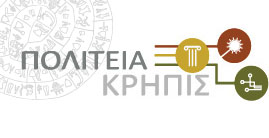Νέα
Ημερίδα Παρουσίασης Αποτελεσμάτων του Προγράμματος ΚΡΗΠΙΣ – ΠΟΛΙΤΕΙΑ
Παρασκευή 18 Δεκεμβρίου 2015, ώρα 18:00-21:15
Ινστιτούτο Μεσογειακών Σπουδών – Ίδρυμα Τεχνολογίας και Έρευνας
Αίθουσα Διαλέξεων ΙΜΣ, Νικ. Φωκά 130, Ρέθυμνο (Παλιά Πόλη)
ΠΡΟΓΡΑΜΜΑ ΗΜΕΡΙΔΑΣ
18:00- 18:15 Χαιρετισμοί και Ενημέρωση
Α. Τζιγκουνάκη & Δ. Άγγλος
EΦΟΡΕΙΑ ΑΡΧΑΙΟΤΗΤΩΝ ΡΕΘΥΜΝΟΥ
ΙΝΣΤΙΤΟΥΤΟ ΗΛΕΚΤΡΟΝΙΚΗΣ ΔΟΜΗΣ & ΛΕΙΖΕΡ (ΙΗΔΛ)
18:15-18:30 Αποκωδικοποίηση του χώρου με επίγειες και δορυφορικές τεχνικές χαρτογράφησης.
Α. Σαρρής, Τ. Kalayci, F-X. Simon, J. Donati, C. CuencaGarciá, C., Ι. Moffat, N. Aργυρίου, G. Cantoro, M. Μανατάκη & Ν. Νίκας
ΙΝΣΤΙΤΟΥΤΟ ΜΕΣΟΓΕΙΑΚΩΝ ΣΠΟΥΔΩΝ (ΙΜΣ)
18:30-18:45 Τομογραφικές γεωφυσικές τεχνικές για την αναπαράσταση θαμμένων μνημείων πολιτισμικής κληρονομιάς.
Ν. Παπαδόπουλος, G. Cantoro & A. Σαρρής
ΙΝΣΤΙΤΟΥΤΟ ΜΕΣΟΓΕΙΑΚΩΝ ΣΠΟΥΔΩΝ (ΙΜΣ)
18:45-19:00 Η εφαρμογή της Φωτογραμμετρίας στην Πολιτιστική Κληρονομιά. Πέρα από μία απλή τεκμηρίωση.
G. Cantoro
ΙΝΣΤΙΤΟΥΤΟ ΜΕΣΟΓΕΙΑΚΩΝ ΣΠΟΥΔΩΝ (ΙΜΣ)
19:00-19:15 Ιστορική γεωγραφική πληροφορία: πρότυπα και σημασιολογία.
E. Γκαδόλου
ΙΝΣΤΙΤΟΥΤΟ ΥΠΟΛΟΓΙΣΤΙΚΩΝ ΜΑΘΗΜΑΤΙΚΩΝ (ΙΥΜ)
19:15-19:30 Εφαρμογή της οδηγίας INSPIRE για την τεκμηρίωση χώρων πολιτιστικής κληρονομιάς.
Π. Πραστάκος & Ε. Γκαδόλου
ΙΝΣΤΙΤΟΥΤΟ ΥΠΟΛΟΓΙΣΤΙΚΩΝ ΜΑΘΗΜΑΤΙΚΩΝ (ΙΥΜ)
19:30-19:40 Διάλειμμα
19:40-19:50 Φορητές διατάξεις και οργανολογία για την επιτόπια ανάλυση υλικών, δομική διάγνωση και συντήρηση/αποκατάσταση αντικειμένων πολιτισμικής κληρονομιάς και μνημείων.
Π. Σιώζος, Κ. Χατζηγιαννάκης, Α. Φιλιππίδης, Ζ. Παπλιάκα, Κ. Μελεσανάκη, Ε. Μπερνικόλα, Μ. Ανδριανάκης, Β. Τορνάρη, Π. Πουλή, Δ. Άγγλος
ΙΝΣΤΙΤΟΥΤΟ ΗΛΕΚΤΡΟΝΙΚΗΣ ΔΟΜΗΣ & ΛΕΙΖΕΡ (ΙΗΔΛ)
19:50-20:00 Μελέτη των χρωστικών στις οθωμανικές επιγραφές του Ιστορικού Μουσείου Κρήτης
Μ. Βακονδίου, Π. Σιώζος, Α. Φιλιππίδης, Ζ. Ε. Παπλιάκα, Κ. Μελεσανάκη & Δ. Άγγλος
ΙΝΣΤΙΤΟΥΤΟ ΜΕΣΟΓΕΙΑΚΩΝ ΣΠΟΥΔΩΝ (ΙΜΣ)
ΙΝΣΤΙΤΟΥΤΟ ΗΛΕΚΤΡΟΝΙΚΗΣ ΔΟΜΗΣ & ΛΕΙΖΕΡ (ΙΗΔΛ)
20:00-20:15 Τεκμηρίωση Αναλυτικών Επιστημονικών Μεθόδων
X. Μπεκιάρη, Μ. Doerr.
ΙΝΣΤΙΤΟΥΤΟ ΠΛΗΡΟΦΟΡΙΚΗΣ (Ι.Π.)
20:15-20:30 Γενετική ταυτότητα, καταγωγή και ποικιλότητα του ανθρώπου.
Δ. Καφετζόπουλος
ΙΝΣΤΙΤΟΥΤΟ ΜΟΡΙΑΚΗΣ ΒΙΟΛΟΓΙΑΣ ΚΑΙ
ΒΙΟΤΕΧΝΟΛΟΓΙΑΣ (ΙΜΒΒ)
20:30-20:45 IPERION-CH.gr: Διεπιστημονικές Ερευνητικές Υποδομές ως εργαλεία στήριξης & ενίσχυσης της έρευνας στην Πολιτισμική Κληρονομιά. Προοπτικές στην Ευρώπη & την Ελλάδα.
Δ. Άγγλος
ΙΝΣΤΙΤΟΥΤΟ ΗΛΕΚΤΡΟΝΙΚΗΣ ΔΟΜΗΣ & ΛΕΙΖΕΡ (ΙΗΔΛ)
20:45 Συζήτηση
LASER SYNTHESIS and POLYGNOSIS; The POLITEIA Documentation System and Knowledge Platform
November 23- 27, 2015
IESL-FORTH, Heraklion, Crete, Greece
WORKSHOP AIMS AND CONTENT
LASER SYNTHESIS and POLYGNOSIS workshop will introduce participants to the use of the documentation System and the knowledge platform that have been developed in the framework of POLITEIA with the aim to archive and handle the multifaceted data recorded upon the use of modern laser diagnostic and analytical techniques developed at IESL-FORTH. This training workshop aims to bridge the gap between Conservation and Laser Science and is a collaborative outcome of the Institute of Electronic Structure and Laser (IESL) and the Institute of Computer Science (ICS) of the Foundation for Research and Technology-Hellas (FORTH) on the basis of research conducted at FORTH.
The workshop is addressed to young scientists experienced to the use of these laser analytical and diagnostic techniques with the objective to evaluate the two tools, LASER SYNTHESIS and POLYGNOSIS, and optimise their use and applicability in order to make new knowledge on laser technologies more reachable and comprehensible to CH professionals and scholars.
WORKSHOP SERIES OUTLINE:
The lectures will introduce participants to the structure and use of the developed Documentation System and Knowledge Platform. In parallel the general concepts and principles of operation of each laser-based technique with emphasis on their data recording, manipulation and post-processing will be also highlighted. Practical work on the introduction of data from selected examples and case studies into the SYNTHESIS and POLYGNOSIS tools is also foreseen.
TOPICS
- Documentation Systems and Knowledge Platforms
- Materials analysis with Optical Spectroscopy (LIBS, Raman)
- Optical coherence metrology for structural diagnosis
- Imaging and mapping; multispectral, multi-photon and THz
PARTICIPANTS:
Maximum number of participants: 10
The workshop concept relies on a) strong and effective interaction between participants and instructors and b) team work on uploading and manipulating data. Therefore participants will be organized in five groups of two
COST
The course-fee is funded by the KRIPIS-POLITEIA research project
| Εμπλεκόμενα Ινστιτούτα: |
|---|
| Ινστιτούτο Ηλεκτρονικής Δομής και Λέιζερ |
| Ινστιτούτο Πληροφορικής |
25 September 2015, Researchers Night 2015
The 10th anniversary of “Researchers’ Night” was successfully celebrated at FORTH premises on the 25th of September 2015, attracting more than 1500 visitors of all ages.
A special thematic on research, applications and infrastructures entitled “Cultural Heritage @ FORTH” was organized disseminating the work performed in the framework of KRIPIS-POLITEIA project, as well as the research infrastructures available under the IPERION-CH.gr umbrella.
Presented Activities
- Lasers for Cultural Heritage analysis, diagnosis and conservation:
Laser based systems, developed at IESL-FORTH, for analysis, diagnosis and conservation of artworks and monuments will be presented. Emphasis will be given to videos and photos describing typical examples (IPERION-CH.gr) and in-situ applications (KRIPIS-POLITEIA).
- Laboratory of Geophysical – Satellite Remote Sensing and Archaeo-environment:
Presentation of methodological approaches and results on the implementation of ground, aerial and satellite remote sensing prospection techniques and GIS management of CH monuments and sites in the framework of the KRIPIS-POLITEIA research project. (Ιnstitute of Mediterranean Studies).
- Analysis of ancient DNA. A completely new view of the past:
Can we retrieve DNA from objects found in archaeological excavations such as bones from humans and animals or food residues such as olives and beans? Now, in the first laboratory for analysis of ancient DNA in Greece, which is equipped with specialized and modern technologies (as used in forensic research) we can! With these analyses we can shed light on the origin and migration of populations and for the first time understand in detail how ancient farmers produced and stored food and merchandise. We can open a window to our past.
- The Information System for Cultural Heritage. Exploring the Byzantine World:
Τargeted digital content showcasing the Byzantine culture will be presented. The e-services created within the “Exploring the Byzantine World” project are designed to inform teachers, researchers, schoolchildren and interested members of the general public about monuments, persons, historical events, achievements and aspects of daily life in Byzantium. A set of interactive educational activites that will enable students to discover Byzantium by playing, will also be available. - Reasoning on Virtual Reconstruction:
On-going results of the Marie Curie ITN-DCH project, “Initial Training Network for Digital Cultural Heritage (ITN-DCH): Projecting our Past to the Future” which is the first and one of the largest Marie Curie fellowship projects in the area of the e-documentation / e-preservation and CH protection funded by the European Union under the FP7 PEOPLE research framework. The poster will present virtual reconstruction as the basis for understanding the past both by experts and the general public. It discusses the methodolgy for creating 3D models as accurate representations of a monument or an archaeological site. It proposes an information system that supports argumentation and reasoning on the virtual reconstructions and the 3D models. - Initial Training Network for Digital Cultural Heritage:
Rendering and animation in mobile VR and AR: On-going results of the Marie Curie ITN-DCH project. The “Initial Training Network for Digital Cultural Heritage (ITN-DCH): Projecting our Past to the Future” with acronym ITN-DCH, is the first and one of the largest Marie Curie fellowship projects in the area of the e-documentation / e-preservation and CH protection funded by the European Union under the FP7 PEOPLE research framework. The Project started on the 1st of October 2013 and its consortium comprising of 14 full partners and 8 associate members covering the entire spectrum of European CH actors, ranging from academia, research institutions, industry, museums, archives and libraries. In this demo we illustrate recently published, on-going Virtual Reality and Augmented Reality applications for digital heritage preservation and curation that allow real-time simulation of virtual characters, rendering and animation. - Characterization of building elements and materials and methods for historic monuments’ conservation:
Recent research and advances as regards the characterization of building elements as well as new materials and methods for historic monuments’ conservation will be presented by the Institute of Chemical Engineering Sciences of FORTH. - Climatic changes and coastal monuments:
Presentation of the contribution of the Coastal Research Laboratory of Institute of Applied and Computational Mathematics (IACM)of FORTH in the study of climate change on coastal environment (sea level rising, intensification of extreme weather events, erosion, safety of coastal infrastructure) and its impact on the natural environment and cultural heritage. Risk assessment from the climatic change can contribute, through smart specialization, in the protection and restoration of coastal monuments, and resilience development of economic activities associated with them, such as tourism. - Interactive systems in the domain of cultural heritage:
The presentation will focus on interactive systems developed by ICS in the domain of cultural heritage. These systems are facilitated for presenting cultural information, allowing the interaction of users with cultural resources in digital form and the augmentation of artefacts with digital information. The presentation will also include content that demonstrates the practical exploitation of these systems within cultural heritage institutions. Furthermore the “TimeViewer” system will be demonstrated. “TimeViewer” is an interactive system that presents information with temporal characteristics in a large scale display, while user interaction is achieved through remote gesturing. Besides representing information as a traditional two- dimensional timeline, the system also supports three- dimensional information representation in a “time – tunnel”, i.e., a corridor along which the events are placed with chronological order. User interaction in the time – tunnel is accomplished through full – body kinesthetic interaction.
Further info: http://www.researchersnight.gr/6A99428B.el.aspx
| Εμπλεκόμενα Ινστιτούτα: |
|---|
| Ινστιτούτο Ηλεκτρονικής Δομής και Λέιζερ |
| Ινστιτούτο Μεσογειακών Σπουδών |
| Ινστιτούτο Πληροφορικής |
| Ινστιτούτο Υπολογιστικών Μαθηματικών |
| Ινστιτούτο Επιστήμης Χημικής Μηχανικής |
| Ινστιτούτο Μοριακής Βιολογίας και Βιοτεχνολογίας |
KRIPIS-POLITEIA campaign at Byzantine and Christian Museum, Athens, 15-18 June 2015
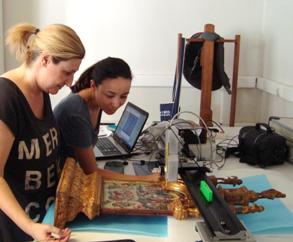
In-situ characterization of pigments in Russian icons, with LMntII portable instument
Laser-induced breakdown spectroscopy (LIBS) and Raman microspectroscopy, based on mobile instrumentation, have been moved to the Byzantine and Christian Museum in Athens (Greece) for the in-situ characterization of pigments in Russian icons. Aim of this study is the identification of pigments in those high artistic quality paintings so as to aid historians to understand the technical background of the icons and conservators to apply the most appropriate conservation treatments. All analyses were performed in the conservation laboratory of the museum, directly on the objects thus eliminating sampling and transportation of the icons.
The analytical investigartion has been performed by the scientists of the Institute of Electronic Structure and Laser, Foundation for Research and Technology-Hellas (IESL-FORTH) :D. Anglos, Z.E. Papliaka, P. Siozos, A. Philippidis.
The campaign was financed by the research project “POLITEIA”(POLitismos-TEchnologIA, New Technologies in the Research, Study, Documentation and Access to the Information for Cultural Heritage Objects and Monuments), Action KRIPIS, project No MIS-448300 (2013SE01380035).
We also greatly appreciate the excellent collaboration with the archaeologist Dr. Nikos Kastrinakis and the conservators of the Byzantine and Christian Museum, Tzeni Perdikari, Maria Filipoussi, Rena Tsivgouli and Sophia Tzavara, as well as the valuable guidance of Dr. Juliana Boycheva from the Institute of Mediterranean studies (IMS) of FORTH. ∞
| Εμπλεκόμενα Ινστιτούτα: |
|---|
| Ινστιτούτο Ηλεκτρονικής Δομής και Λέιζερ |
| Ινστιτούτο Μεσογειακών Σπουδών |
OPTO-CH POLITEIA 2015 workshop May 04 – 10, 2015
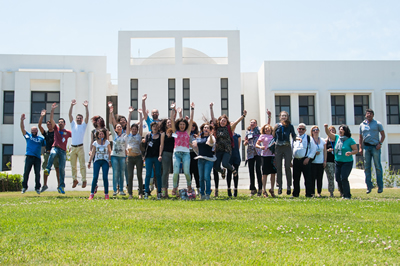
Group photo of the OPTO-CH POLITEIA 2015 workshop, 04-10 May 2015
Dear friends,
We would like to extend our sincere thanks to all of you for your active participation in OPTO-CH POLITEIA 2015 Workshop “Laser technologies in Cultural Heritage analysis, diagnosis and conservation”
We are indeed very happy that you have been with us at Heraklion and hope that you found the workshop to have fulfilled its objectives, namely, to introduce participants to the latest developments and achievements in the field, to give a real feeling on how a number of laser-based analytical and conservation tools may be used in research and practice, as well as to demonstrate the in-situ applicability of the portable laser analytical and diagnostic techniques on a Byzantine monument.
We are also grateful to our visiting lecturers for enhancing the overall impact of the workshop with their excellent and high-level presentations.
Once again thank you for your participation.
The organising committee
Find more info at : http://www.iesl.forth.gr/research/course.aspx?id=5
| Εμπλεκόμενα Ινστιτούτα: |
|---|
| Ινστιτούτο Ηλεκτρονικής Δομής και Λέιζερ |
RESTECH II 9th-20th February 2015, Réthymno, Greece.
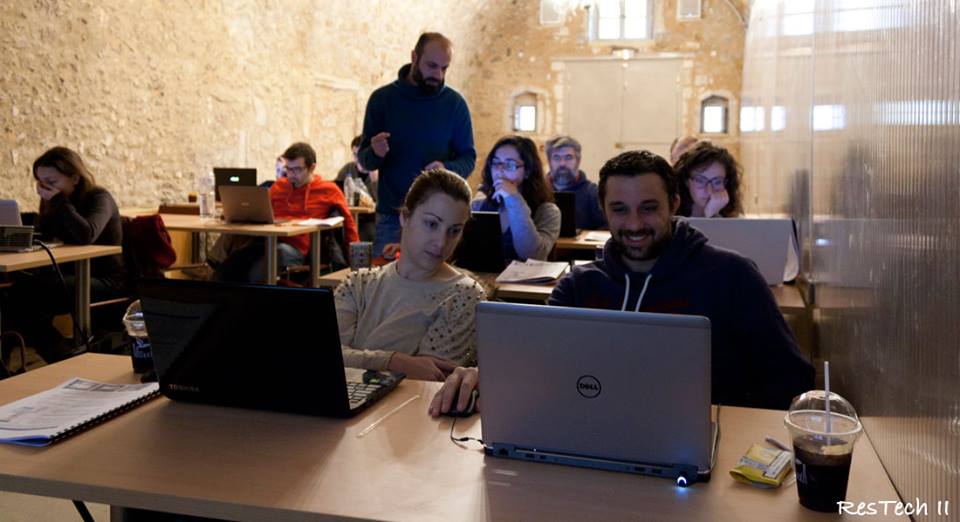
2nd REmote Sensing Technologies in Cultural Heritage Workshop
9th-20th February 2015
The main scope of RESTeCH II Workshop is to introduce undergraduate and graduate students, post doc researchers and professionals to the basic operations and spatial analyses of Geographical Information Systems (GIS) within the domain of cultural heritage and cultural resources management.
The Workshop is organized under the framework of “KRIPIS – POLITEIA: Culture-Technology: New technologies in research, study, documentation and accessibility in the information of items and monuments of cultural heritage (2013-2015)”, that is financed by the Operational Program «Competitiveness and entrepreneurship» of the National Strategic Reference Framework (NSRF 2007-2013). POLITEIA intends to develop a protocol for the implementation of an integrated system for mapping the cultural environment through innovative technologies for the imaging the subsurface and the surface of archaeological sites.
Find more info at: http://www.ims.forth.gr/restech2015
| Εμπλεκόμενα Ινστιτούτα: |
|---|
| Ινστιτούτο Μεσογειακών Σπουδών |
KRIPIS-POLITEIA campaign at St George church of Kamariotis Village in Crete, 04-05 Dec. 2014
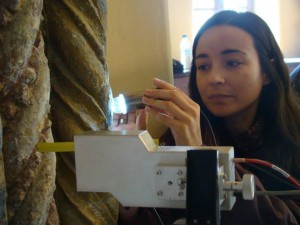
LIBS, Raman and Multi-Spectral portable instruments have been moved to Kamariotis village, in the South-west of Heraklion in Crete, to study pigments on the painted sculpted stone “Thiroma” of St George church (15th c AC). This study revealed the composition and stratigraphy of the pigments allowing the historians to get useful information on the artistic and historic background of the “Thiroma”.
The campaign was financed by the research project “POLITEIA” (POLitismos-TEchnologIA, New Technologies in the Research, Study, Documentation and Access to the Information for Cultural Heritage Objects and Monuments), Action KRIPIS, project No MIS-448300 (2013SE01380035).
We also greatly appreciate the excellent collaboration with the 13th Ephory of Byzantine Antiquities, as well as the valuable guidance of Maria Vacondiou, Institute of Mediterranean studies (IMS) of FORTH.
| Εμπλεκόμενα Ινστιτούτα: |
|---|
| Ινστιτούτο Ηλεκτρονικής Δομής και Λέιζερ |
KRIPIS-POLITEIA campaign at the Historical Museum of Crete, 26-27 Nov. 2014
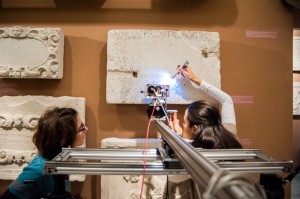
LIBS and Raman portable instruments have been moved to the Historic Museum of Crete, in Heraklion to study traces of pigments on stone sculptures with Venetian and Ottoman inscriptions. This study revealed the composition of the pigments and allowed the historians to get useful information on the artistic and historic background of these objects.
The campaign was financed by the research project “POLITEIA” (POLitismos-TEchnologIA, New Technologies in the Research, Study, Documentation and Access to the Information for Cultural Heritage Objects and Monuments), Action KRIPIS, project No MIS-448300 (2013SE01380035).
We also greatly appreciate the excellent collaboration and worm hospitality of the Historic Museum of Crete, as well as the valuable guidance of Maria Vacondiou, Institute of Mediterranean studies (IMS) of FORTH.
| Εμπλεκόμενα Ινστιτούτα: |
|---|
| Ινστιτούτο Ηλεκτρονικής Δομής και Λέιζερ |
KIPIS POLITEIA – Lasers Cleaning on Modern Materials, Nov. 2014
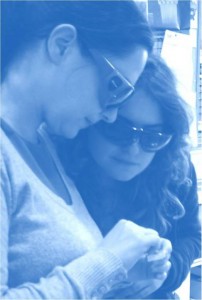
Rresearch on laser cleaning challenges of modern polymeric materials in collaboration with Chiara Russo and Grazia De Cesare, Academy of Fine Arts in L’Aquila.
This work was financed by the research project “POLITEIA”(POLitismos-TEch
| Εμπλεκόμενα Ινστιτούτα: |
|---|
| Ινστιτούτο Ηλεκτρονικής Δομής και Λέιζερ |
POLITEIA campaign at the 13rd EBA Conservation Labs, Sept. 2014
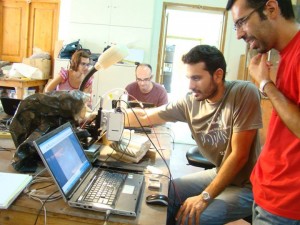
LIBS and Raman portable instruments have been moved to the Conseervation Laboratories of the 13rd Ephory of Byzantine Antiquities (EBA), in Heraklion to study traces of pigments on stone sculptures with inscriptions. This study revealed the composition of the pigments and allowed the historians to get useful information on the artistic and historic background of these objects.
The campaign was financed by the research project “POLITEIA” (POLitismos-TEchnologIA, New Technologies in the Research, Study, Documentation and Access to the Information for Cultural Heritage Objects and Monuments), Action KRIPIS, project No MIS-448300 (2013SE01380035).
We also greatly appreciate the excellent collaboration and worm hospitallity of the 13rd EBA, particularly the director Vassiliki Sythiakaki, as well as the valuable guidance of Maria Vakondiou, Institute of Mediterranean studies (IMS) of FORTH.
| Εμπλεκόμενα Ινστιτούτα: |
|---|
| Ινστιτούτο Ηλεκτρονικής Δομής και Λέιζερ |
